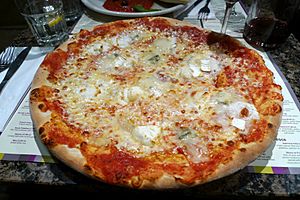Pizza quattro formaggi facts for kids
 |
|
| Type | Pizza |
|---|---|
| Place of origin | Italy |
| Main ingredients | Mozzarella, Gorgonzola, Fontina and Parmesan |
Pizza quattro formaggi is a super yummy Italian pizza! Its name means "four cheese pizza" in Italian. It's covered with a mix of four different kinds of cheese. These cheeses usually melt together when cooked. Sometimes it has tomato sauce, and sometimes it doesn't! This pizza is loved all over the world, especially in Italy. It's a famous dish you'll often find in pizzerias.
The Story of Four Cheeses
This special pizza has a less clear history than some other famous pizzas. For example, pizzas like the Margherita have very old stories. But the "Four Cheese" pizza is believed to have started in the Lazio region of Italy. This was around the early 1700s.
What Cheeses Are Used?
Traditionally, one main cheese is always used: Mozzarella. Mozzarella helps keep the pizza moist. It also protects the other cheeses from getting too hot in the oven.
Another cheese you'll almost always find is Gorgonzola. It's a blue cheese with a strong flavor. The other two cheeses often depend on where the pizza is made. Common choices are Fontina and Parmigiano-Reggiano.
- Other cheeses that can be used include:
When pizzas are made in large amounts, they often use Parmesan, Romano, and Asiago. Some even use cheeses from other countries. These can include Edam, Emmental, or other blue cheeses.
The cheeses are chosen carefully. They should be full-fat or semi-fat. They also need to have different flavors. Besides Mozzarella, a "quattro formaggi" pizza usually has:
- A blue or mature cheese (like Gorgonzola)
- A soft cheese (like Emmental or Gruyère)
- A creamy cheese (like Robiola or Stracchino)
- A hard cheese (like Parmesan or Pecorino, which is often grated)
See also
 In Spanish: Pizza cuatro quesos para niños
In Spanish: Pizza cuatro quesos para niños

